Most businesses lose time and money on document management. In the U.S. alone, offices consume 12.1 trillion sheets of paper each year.1
But this use of paper doesn’t increase productivity and revenue.
Document management software (DMS) is aimed at streamlining and automating most of the document management routine (and reducing the number of errors).
Additionally, modern document management software supports global efforts against deforestation and promotes companies’ green goals.
Let’s delve into the document management software (DMS) world and review the best of these systems.
Best document management systems at a glance
- Best overall: PandaDoc
- Best advanced digital asset management: Bynder
- Best for sales agreements: DocuSign
- Best with AI assistant: Microsoft 365
- Best for legal pros: Legito
- Best native cloud infrastructure: Dropbox Business
- Best for enterprises: DocuWare
- Best with a classic UI: FileHold
- Best open-source option: LogicalDoc
- Best for midsize businesses: Bitrix24
What is document management software?
First of all, let’s define what document management systems are.
A document management system is software that streamlines and automates the creation, receipt, storage, editing, and tracking of documents electronically, significantly reducing paper use.
Most state-of-the-art document management systems use AI to extract data from documents and automate classifications.
AI-driven analytics and document processing give teams quick access to organized information, making them more productive.
Another feature that steps up document management is workflow automation.
Its real power lies in helping teams precisely manage the document lifecycle.
For example, documents can be automatically routed based on rules to reach those responsible for approval.
Typical DMS features
Before reviewing the best DMS software, let’s take a look at the typical features of such systems:
- Archiving and retention — storing data that isn’t actively used at the time
- Collaboration — sharing and editing files collaboratively within the working group
- Compliance tracking — tracking regulatory changes, along with reporting
- Classification system — labeling or tagging docs so they can be found quickly
- Document generation — automatically generating document templates
- Document tracking — streamlining final negotiation and signing
- AI functionality — harnessing AI to extract data from documents, automate classification, and identify patterns
- Workflow automation — simplifying the document management lifecycle and boosting work efficiency
- eSignature — enabling online signing with authenticated electronic signatures, without the need for a wet signature on paper
- File converter — converting between file types, such as DOC to PDF
- File recovery — restoring lost files from automatically created backups
- Offline mode — syncing changes made to a document while offline once the connection is restored
- Text recognition — recognizing printed or handwritten text from scanned documents
- Version control — restoring documents to previous versions
Not all DMS software offers all the features mentioned above. That’s why it’s important to thoroughly evaluate options when choosing the best system for your company.
Overview of the 10 best document management software tools
1. PandaDoc
| Price | Best for | Ease of use | Functionality | Free trial |
|---|---|---|---|---|
| $19 to $49/user/month (paid annually) Enterprise plan available |
SMBs and enterprises | 4.7/5 | 4.7/5 | Yes (14 days) |
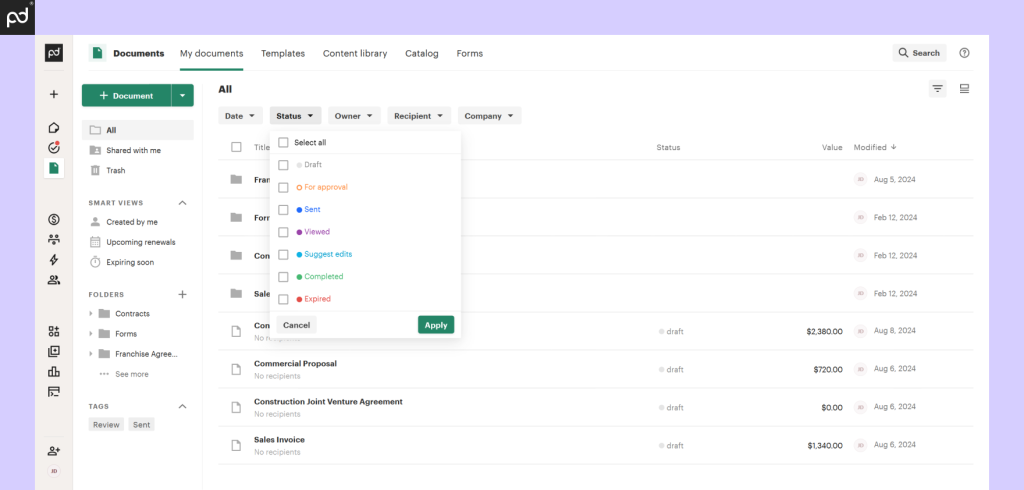
Key features:
- Built-in, highly secure, and free proprietary eSignature functionality
- Huge collection of 1000+ editable document templates (and growing)
- Advanced analytics and document tracking system to track all stakeholder actions, such as reviews and edits
PandaDoc is a business product whose features extend far beyond those of a basic DMS. With the help of PandaDoc, users can cut in half the time they would usually spend working with documents.
This solution offers everything you need for document creation, especially with the Business and Enterprise plans.
Features that are most popular with PandaDoc clients include eSignatures, templates, and document audit trails — all geared towards helping users meticulously manage documents.
You can create a document from scratch in PandaDoc or select a template from the library and customize it.
With more than 1000 templates for different types of documents, you’ll easily find one that fits your unique business case.
Templates are extremely popular, and 85,000 PandaDoc clients have already used them to create professional business documents.
More reasons to choose PandaDoc:
- The content library allows you to manage, create, and share well-organized content.
- PandaDoc helps you keep documents consistent and change their branding in bulk with a few clicks.
- The collaboration feature makes sharing documents easy and allows team members to simultaneously access and edit them.
- You can work with documents from home, the office, or on business trips using various devices.
- You can easily set up your document workflow and automate routine tasks.
- PandaDoc integrates with third-party software like CRMs and project management tools.
- All documents created with PandaDoc comply with the GDPR, HIPAA, and FERPA standards, and a permissions system controls secure access for specific users.
2. Bynder
| Price | Best for | Ease of use | Functionality | Free trial |
|---|---|---|---|---|
| Not provided by the vendor | Midsize businesses (50+ users) and enterprises | 4.6/5 | 4.3/5 | Yes (14 days) |

Key features:
- Bynder simplifies content creation with a powerful digital asset management platform.
- Brand guidelines help align all content pieces to make them fully consistent with your brand.
- The creative workflow module simplifies and automates your most creative tasks, making it easier to bring your ideas to life.
Bynder is digital asset management (DAM) software for handling all types of digital content, not just documents.
The system offers a lot for creative production and marketing teams such as branding, advanced custom themes, and advertising management features.
At the same time, the Bynder document management module offers most features you would expect in a document management system (DMS).
More reasons to choose Bynder:
- Centralized storage allows you to store business documents as well as pictures, videos, and other types of content.
- You can categorize and share documents, add watermarks, and embed special codes.
- The user interface adapts to different display sizes.
- You can adjust the default workflows, add branding guidelines, add comments and annotations, and quickly approve changes.
- The template collection is constantly growing.
- Bynder integrates with multiple third-party solutions.
- Although Bynder doesn’t offer a free plan, it has a trial period.
3. DocuSign
| Price | Best for | Ease of use | Functionality | Free trial |
|---|---|---|---|---|
| $10 to $40/user/month (paid monthly) Free version |
SMBs and enterprises | 4.7/5 | 4.4/5 | Yes (30 days) |
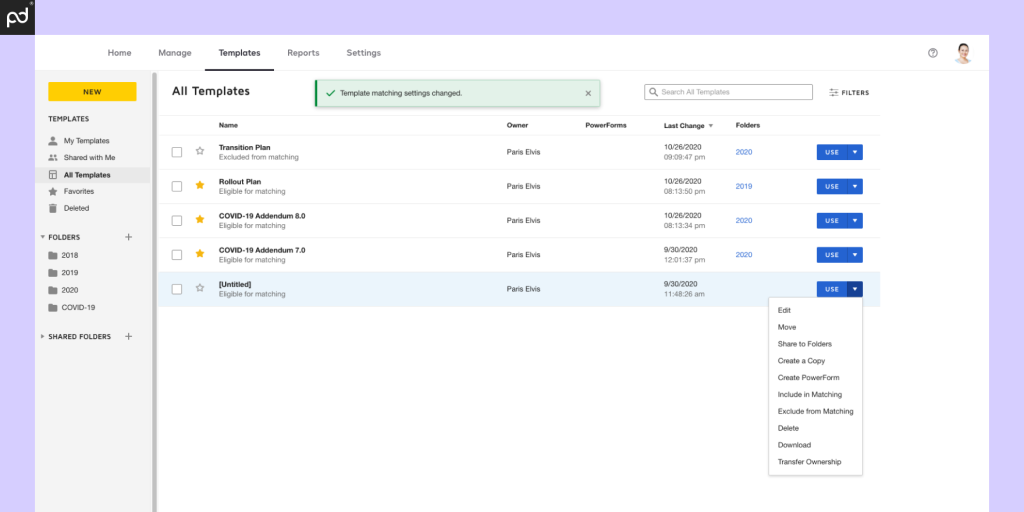
Key features:
- The built-in eSignature solution is DocuSign’s flagship feature, with the focus of DocuSign being on agreements and other business documents.
- Contract collaboration automation appears at every stage of the contract lifecycle.
- An advanced API coupled with hundreds of out-of-the-box integrations (including CRM, project management, corporate communication, payment, and so on) makes implementation easier.
A long-time leader as an eSignature tool, DocuSign has evolved into a suite of digital document management tools that works with documents in various formats.
The DocuSign document generation feature, named Gen, acts in tandem with Salesforce, using the CRM as a source of data about a company, their offers, and their customers.
This solution focuses on agreements and sales-related documents like NDAs, SOWs, MSAs, quotes, and proposals.
It also includes a built-in payments feature for creating and managing invoices, receipts, and transaction statements.
More reasons to choose DocuSign:
- Once a document is ready, you can save it as a template and use it as a starting point for future documents.
- If a template cannot be changed or can only be changed by certain users, you can lock access with a password.
- A special dashboard shows the current status of documents sent, as well as action history and other data.
- Flexible pricing includes per-user and per-feature options, as well as a free 30-day trial and demo.
4. Microsoft 365
| Price | Best for | Ease of use | Functionality | Free trial |
|---|---|---|---|---|
| $8.25/month (flat rate) $6 to $22/user/month (paid monthly) |
Small businesses (2–10 users) | 4.7/5 | 4.2/5 | Yes (30 days) |
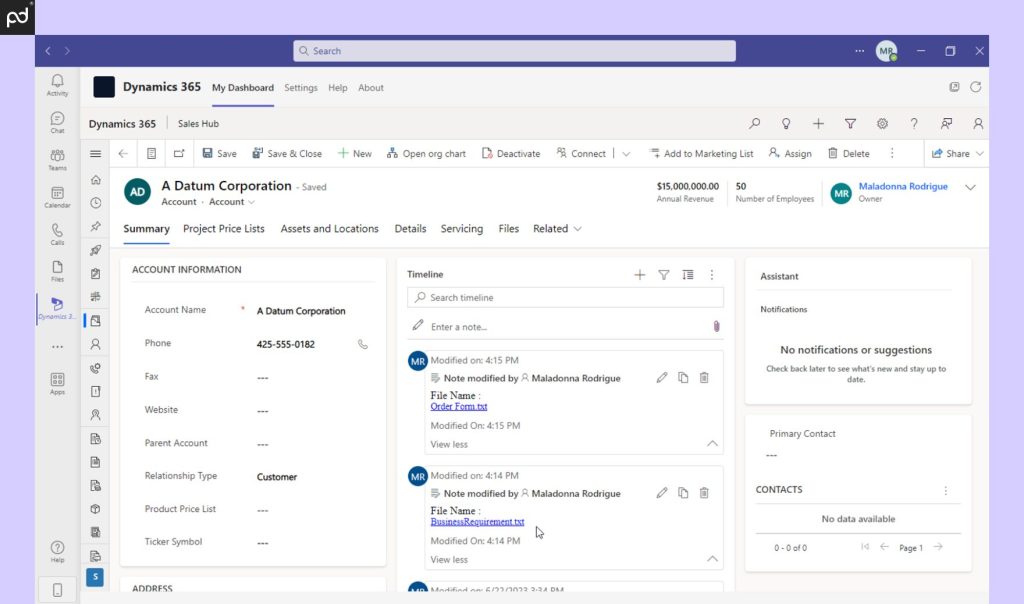
Key features:
- Simple document creation and editing tools make it possible to create and edit documents of any complexity.
- Various business-related Microsoft Azure cloud services help expand the platform’s functionality.
Microsoft 365 (formerly Office 365) is a subscription-based suite of famous office apps including Word, Excel, PowerPoint, Outlook, and others, which are now cloud-based.
Although Microsoft 365 lacks functionality crucial for medium to large businesses (compliance tracking, eSignatures, file conversion), it can be very useful for smaller teams.
This suite allows you to create and edit texts, tables, spreadsheets, and pitch decks of almost any complexity.
You can add formulas, calculations, images, animated graphics, code listings, videos, or any other content types; change formats among a wide variety of options; add macros and scenarios; and do much more.
More reasons to choose Microsoft 365:
- Documents created using this software suite can be saved in various formats.
- You can save files either in your local storage or the cloud thanks to the OneDrive cloud storage service (1 TB of cloud storage is included in all plans). OneDrive offers sharing and collaborative editing.
5. Legito
| Price | Best for | Ease of use | Functionality | Free trial |
|---|---|---|---|---|
| Free/up to 10 users From $1,100/10 users/month (paid annually) |
Legal teams SMEs and enterprises |
4.9/5 | 4.8/5 | Yes (30 days) |
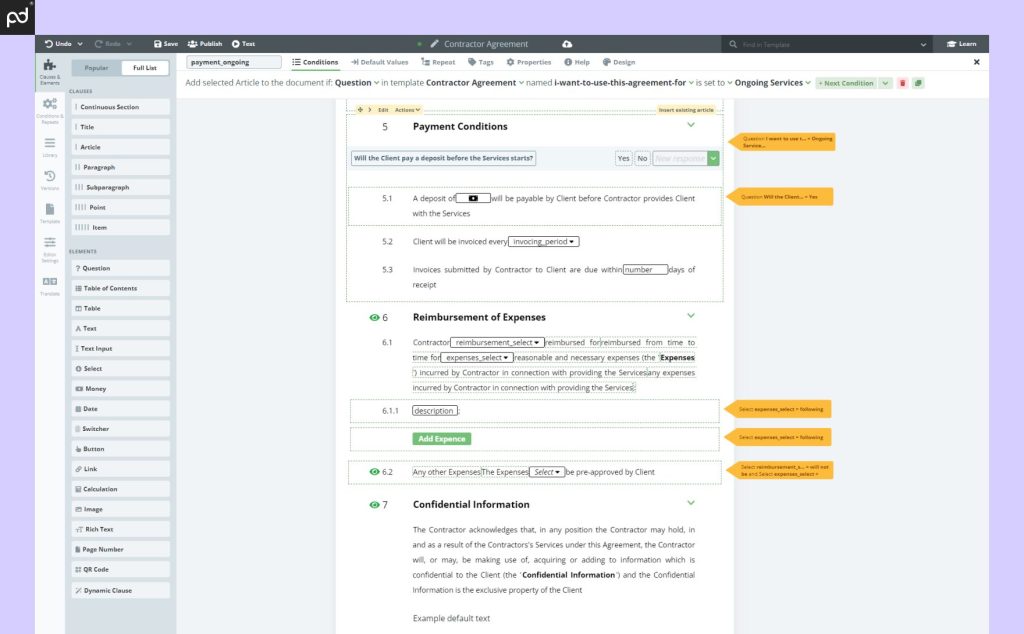
Key features:
- Document management landing page is a powerful web-based dashboard for controlling all processes.
- Legito offers automation features and document templates.
Legito is a relatively new entrant to the busy document management software niche. Released in 2015, the system has now hit its stride and is loved by users.
Its popularity is far behind most other products on our list because of its much higher price point, coupled with a focus on lawyers.
The Legito smart document workspace consists of three separate tools for template automation, smart document drafting, and smart document management, along with a template marketplace.
Legito has a document management landing page — a dashboard to view key information, apply filters, search, check statistics, generate bulk drafts, export CSV records, and download all data with one click.
More reasons to choose Legito:
- You can create unique templates, import and modify existing templates, or use an imported document unchanged.
- Templates combine structural elements and corresponding logical conditions for automation.
- You can import data, including in bulk.
- Smart document management combines all features for workflows in use, data from both generated and uploaded documents, and eSignature features.
- There are two options for eSigning: integration with DocuSign and Legito’s proprietary BioSign technology.
6. Dropbox
| Price | Best for | Ease of use | Functionality | Free trial |
|---|---|---|---|---|
| From €9.99/user/month (paid annually) Free version |
SMEs and enterprises | 4.6/5 | 4.8/5 | Yes (30 days) |
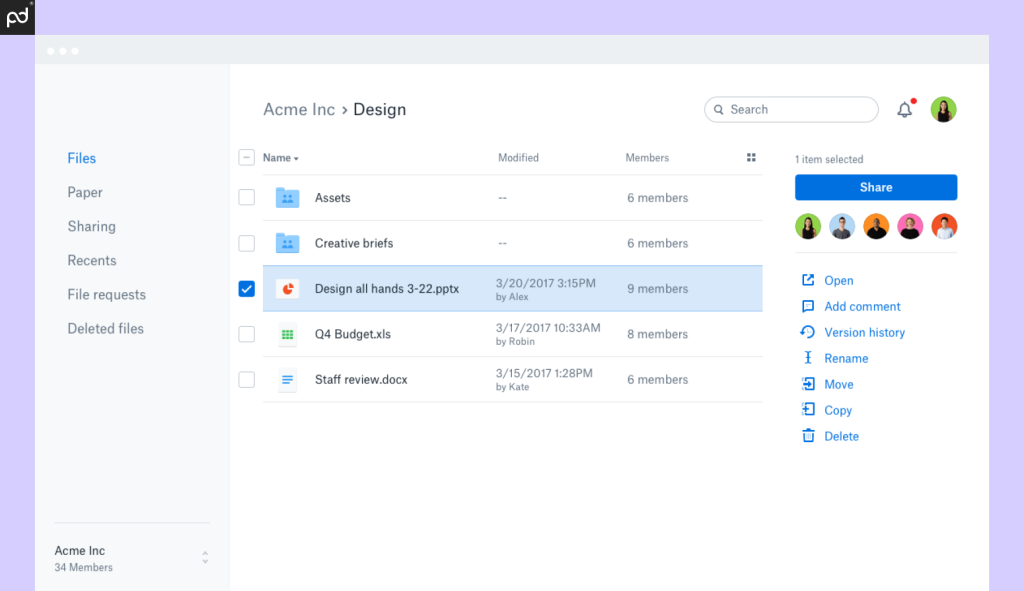
Key features:
- Various business applications within the Dropbox family are available for a single subscription.
- Robust, native cloud infrastructure, DocSend, and paid Transfer are responsible for securely and reliably storing and sending documents with no volume limits.
- Dropbox Paper is a proprietary online editor that streamlines document collaboration.
Launched in 2007 as a cloud file hosting service, Dropbox has finally emerged into something bigger thanks to a few successful acquisitions.
As a result, in 2015, Dropbox Paper was released — an online document editor aimed at creative collaboration.
Paper has a clean and friendly interface.
Despite seeming very simple, the toolbar includes all text formatting features: align text and divide it into paragraphs; add both numbered and bulleted lists; insert tables, images, videos, or even files from Dropbox storage; and convert text strings into to-do list checkboxes.
Users can leave comments, tag each other, and arrange presentations right on Paper.
Dropbox is now a multi-purpose document management service with cloud hosting.
It also offers document automation for sorting files, converting documents to PDF, converting audio and video among different formats, and bulk unzipping of files to specific folders.
More reasons to choose Dropbox:
- You can share your own files or request that others share files right in Dropbox with a few clicks.
- DocSend allows for sending relatively small files securely.
- A paid Transfer feature is available for sharing large files (up to 100 GB for regular accounts and up to 250 GB with a special add-on subscription).
- Dropbox backs up all connected devices in auto mode.
- It provides a built-in electronic signature feature powered by HelloSign (check the comparison with PandaDoc), as well as a password management tool simply named Password.
- The Dropbox App Center is constantly being updated with new apps.
7. DocuWare
| Price | Best for | Ease of use | Functionality | Free trial |
|---|---|---|---|---|
| From $300/4 users/month | SMEs and enterprises | 4.6/5 | 4.8/5 | Yes |
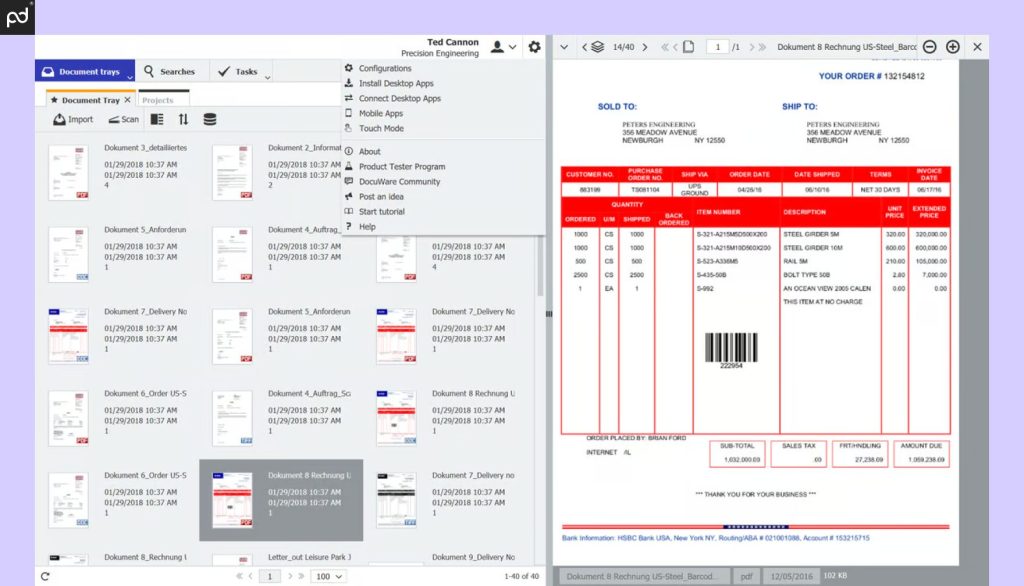
Key features:
- Advanced invoice processing includes preconfigured workflows and tracking tools.
- Intelligent indexing is based on self-learning AI and helps to automatically identify and index data from uploaded documents. It analyzes corrections and adjusts its behavior to avoid mistakes next time.
- Secure cloud storage offers collaborative access to documents based on roles and permissions.
DocuWare was launched at the end of the 1980s and still focuses on enterprise businesses.
It offers almost all features common to DMS software, except for file conversion and document generation (including eSignatures, electronic forms, fast document creation, integrations with third-party software, and so on).
The strongest points of DocuWare are its ability to import documents, work with forms, and process invoices.
You can also easily import any document to DocuWare and save it to secure cloud storage for further use.
More reasons to choose DocuWare:
- Edit documents from storage, collaborate on comments in docs, and assign documents to certain staff members.
- Users with permission can access the system from anywhere using various platforms.
- A workflow automation feature simplifies document handling and allows for storing workflows in the cloud.
- A simple drag-and-drop visual interface makes designing a workflow easy and understandable. Once a workflow is created, you can control it and decide when it will be required.
8. FileHold
| Price | Best for | Ease of use | Functionality | Free trial |
|---|---|---|---|---|
| From $30/5 users/month Enterprise plan prices upon request |
Midsize companies (11+ users) to enterprises | 4.6/5 | 4.8/5 | Yes (10 days) |
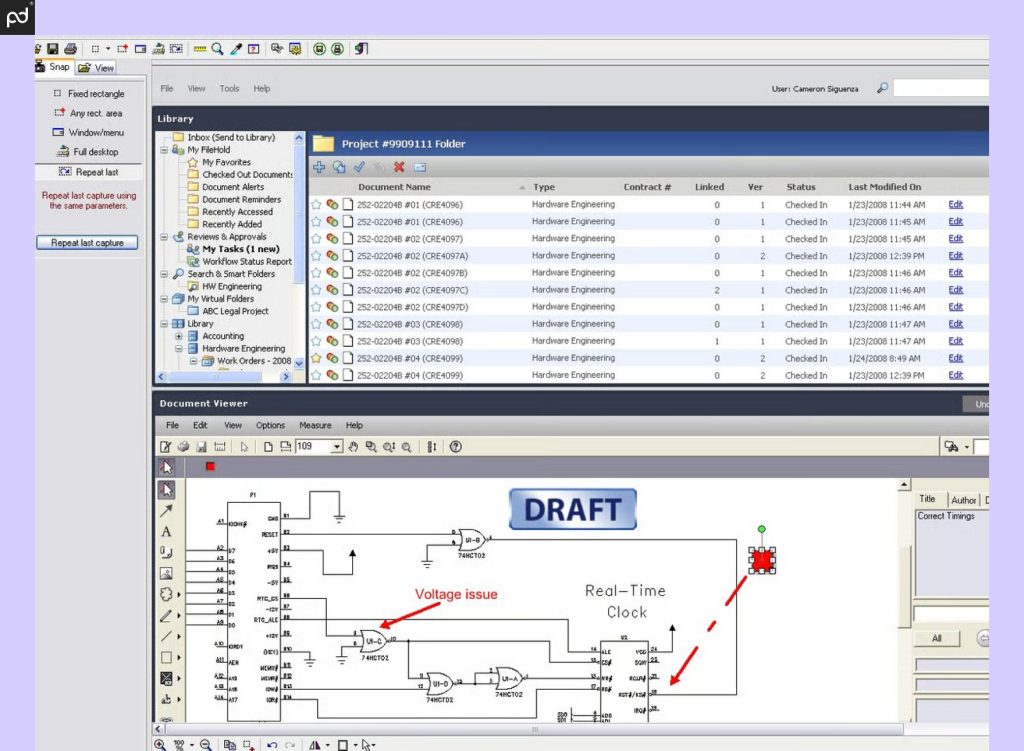
Key features:
- Visual document creation and editing tools offer different capabilities depending on the pricing plan.
- The traditional UI is intuitive and user-friendly.
- Secure cloud storage offers collaborative access to documents based on roles and permissions, including secure transfers and tracking.
- FileHold offers multiple third-party integrations and document-to-document linking.
FileHold is one of the comparatively older market players, having launched in 2005.
The company positions its product as a powerful document workflow and approval automation tool primarily for large organizations.
Although it lacks a free version, it offers a short 10-day trial.
FileHold’s focus is reflected in its traditional user interface (compared to the interfaces of modern cloud solutions).
More reasons to choose FileHold:
- The system is packed with the full set of typical DMS features.
- The built-in document viewing and visual editing tool has three different groups of capabilities depending on the pricing plan.
- The MS document creation software integration can be used for creating and editing documents.
- A scanning, imaging, and recognition feature helps businesses go paperless by scanning and digitizing paper documents.
- Thanks to an electronic form processing feature, FileHold helps make document processing a bit more automated.
- FileHold Courier is aimed at collaborative document management, both inside and outside the organization. It helps to securely deliver documents for approval and sends notifications each time a document is opened by a recipient.
- A version control feature prevents unauthorized changes to documents.
9. LogicalDOC
| Price | Best for | Ease of use | Functionality | Free trial |
|---|---|---|---|---|
| Business, Enterprise, and Cloud Prices upon request Free version |
SMBs and enterprises | 4.6/5 | 4.7/5 | Yes |
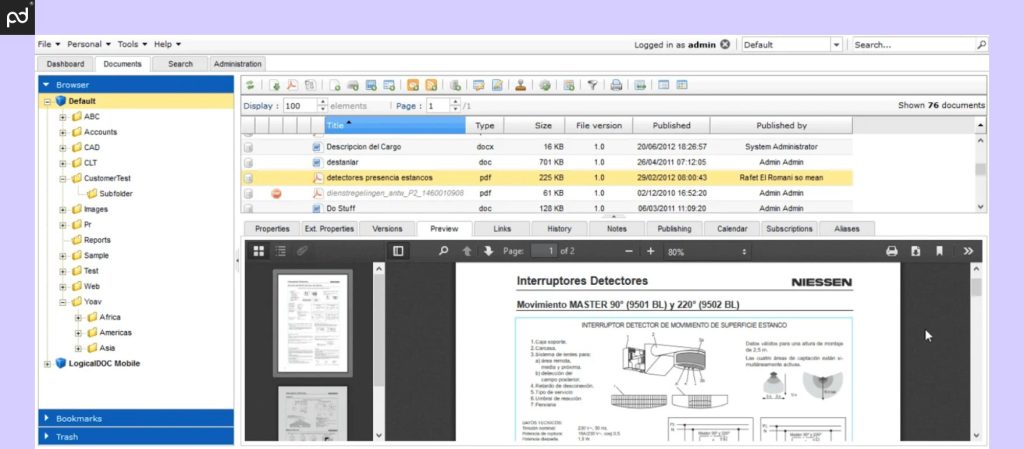
Key features:
- A free, open-source LogicalDOC Community Edition is available with limited capabilities.
- A comprehensive feature set is available at the highest pricing plans.
Founded in 2006, LogicalDOC is a fairly mature service compared with most of the others on this list.
Like many others, it is suited for a wide variety of small, midsize, and large businesses and offers a different set of features depending on the chosen plan.
LogicalDOC positions its product as highly adaptable to the needs of different industries, working with banks, healthcare providers, manufacturers, municipalities, and so on.
More reasons to choose LogicalDOC:
- The free community plan offers all basic features (including document importing) to take the first step towards a paperless business.
- The toolset includes a format converter as well as optical character recognition features.
- While LogicalDOC lacks a visual editor feature like the one PandaDoc has, it offers Google Docs integration out of the box as a primary editing solution (not available in the community edition).
- For imported and digitized documents, LogicalDOC has everything to make your staff’s journey efficient, including multilingual full-text indexing, templates, tags, advanced search for both folders and documents, drag and drop from desktop, bookmarks, and saved search.
10. Bitrix24
| Price | Best for | Ease of use | Functionality | Free trial |
|---|---|---|---|---|
| From $49/5 users/month Free version |
Midsize businesses (50+ users) to enterprises |
4.0/5 | 4.1/5 | Yes |
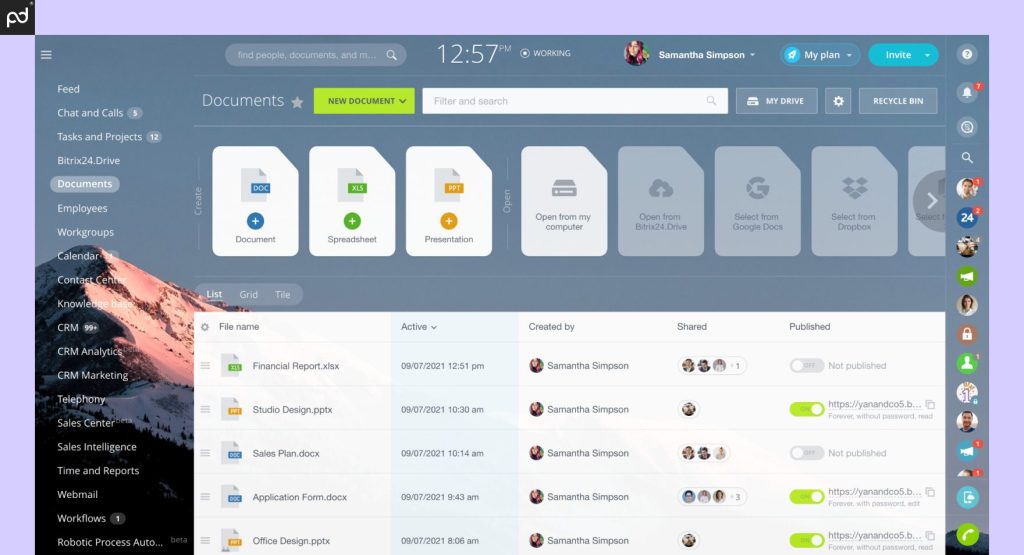
Key features:
- Private cloud storage is limited to 5 GB with a paid plan and can be expanded at additional cost.
- The free plan offers a limited feature set but is available for an unlimited number of users.
- A unique UI aims at efficient collaboration for corporate document management.
- An advanced collaboration system allows for managing permissions in real time and offers immediate user access control.
Bitrix24 isn’t just a document management platform.
This is a full-scope CRM system, combining more than 35 business tools in one platform, and it’s a good fit for both midsize and large businesses.
Advantages of Bitrix24:
- Bitrix24.Drive is private cloud storage with its own UI, aimed at efficient collaboration for corporate document management.
- Storage is limited to 5 GB, but unlimited storage can be had for an additional $199/month.
- You can create and collaborate on documents using the built-in document editor or integrated Microsoft 365 or Google Docs applications.
- Bitrix24 DMS is fully equipped with all the CRM functionality one might expect, along with advanced project management capabilities.
That said, Bitrix24 is much more a CRM rather than a DMS system, and you should keep that in mind when choosing your document management system.
How we sourced data
For our comparison, we relied on trusted sources of information including:
- Well-known software directories: Capterra.com, G2.com, and TrustRadius.com
- Official vendor websites
- Review websites (along with their directories)
User reviews are valuable sources of information but require a critical approach.
On the one hand, they can show you aspects of a product that the vendor doesn’t want to emphasize.
On the other hand, they’re based on personal experience and may be biased.
That’s why we analyzed a high volume of reviews to understand whether the pros and cons described are commonly noted or just the personal opinion of a single reviewer.
How to choose the best document management software for your business
Below are some tips on how to select the right DMS.
- Start from systems that have demos, trials, and free versions.
- Search for specialized document management systems focused on your industry. A DMS that perfectly fits your business can easily justify the price.
- Form a list of required features. Then use the Features filter on Capterra to find matches. This will help you exclude software that has a lot of unnecessary bells and whistles. Moreover, the more unnecessary functionality your software has, the more confusing it could be for your staff.
- Consider software systems that are easy to scale (for example, systems that allow you to buy additional resources without needing to change the pricing plan).
- Try to avoid document management systems that will force you to upgrade to a higher-priced plan just to get documents out the door (for example, if a lower plan offers access to lots of features you don’t use but limits you to 10 documents per month).
- Always read user reviews.
Say goodbye to document chaos with the best document management systems
Traditional paper-based processes not only slow down workflows but also harm the environment.
Your business can reduce its carbon footprint and support a greener planet by using a digital document management solution.
But with so many DMS systems on the market, it can be difficult to choose the right one for your needs.
Moreover, if you focus on sales activities, you might need not only document management but also sales proposal management.
With numerous sales document templates, PandaDoc is the right choice for your sales document management needs.
PandaDoc puts proposal and contract management activities within a single ecosystem, making them more efficient and secure.
And since most deals close with an eSignature on a digital document, make sure your document management software offers this feature.
Over 99,000 PandaDoc accounts have already benefited from eSignature functionality.
Are you ready to start a 14-day free trial of PandaDoc? Contact us and start transforming your document management today!
Disclaimer
PandaDoc is not a law firm, or a substitute for an attorney or law firm. This page is not intended to and does not provide legal advice. Should you have legal questions on the validity of e-signatures or digital signatures and the enforceability thereof, please consult with an attorney or law firm. Use of PandaDocs services are governed by our Terms of Use and Privacy Policy.
Originally published March 3, 2023, updated September 20, 2024
- The World Counts, Paper Waste Facts Show in the article ↑


